
B.Crowell - Vibrations and Waves, Vol
.3.pdf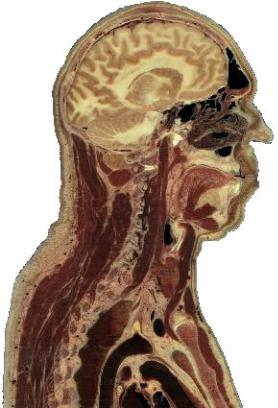
A cross-sectional view of a human body, showing the vocal tract.
4 Bounded Waves
Speech is what separates humans most decisively from animals. No other species can master syntax, and even though chimpanzees can learn a vocabulary of hand signs, there is an unmistakable difference between a human infant and a baby chimp: starting from birth, the human experiments with the production of complex speech sounds.
Since speech sounds are instinctive for us, we seldom think about them consciously. How do we do control sound waves so skillfully? Mostly we do it by changing the shape of a connected set of hollow cavities in our chest, throat, and head. Somehow by moving the boundaries of this space in and out, we can produce all the vowel sounds. Up until now, we have been studying only those properties of waves that can be understood as if they existed in an infinite, open space with no boundaries. In this chapter we address what happens when a wave is confined within a certain space, or when a wave pattern encounters the boundary between two different media, such as when a light wave moving through air encounters a glass windowpane.
61
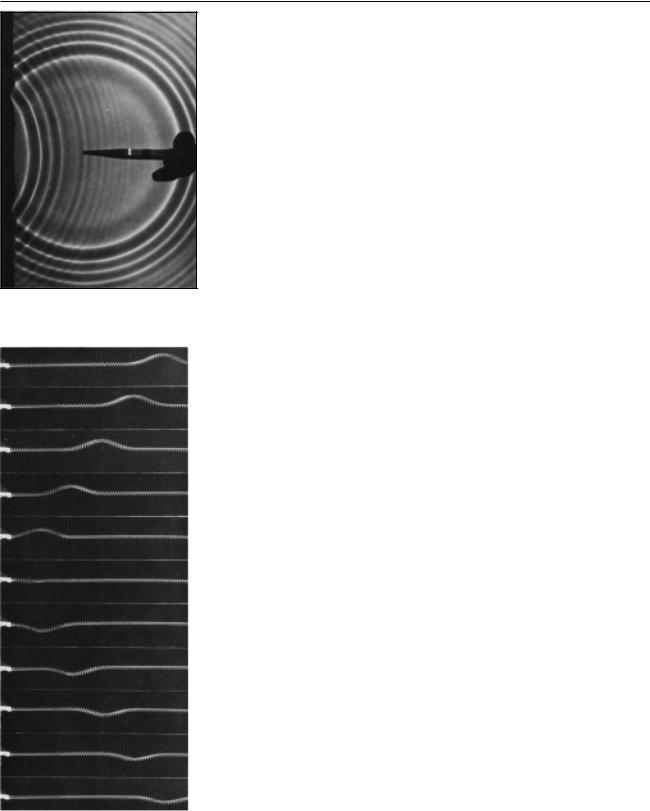
4.1 Reflection, Transmission, and Absorption
(a) Circular water waves are reflected from a boundary on the left.
Uncopyrighted photo from PSSC Physics.
(b) A wave on a coil spring, initially traveling to the left, is reflected from the fixed end.
Uncopyrighted photo from PSSC Physics.
Reflection and transmission
Sound waves can echo back from a cliff, and light waves are reflected from the surface of a pond. We use the word reflection, normally applied only to light waves in ordinary speech, to describe any such case of a wave rebounding from a barrier. Figure (a) shows a circular water wave being reflected from a straight wall. In this chapter, we will concentrate mainly on reflection of waves that move in one dimension, as in figure (b).
Wave reflection does not surprise us. After all, a material object such as a rubber ball would bounce back in the same way. But waves are not objects, and there are some surprises in store.
First, only part of the wave is usually reflected. Looking out through a window, we see light waves that passed through it, but a person standing outside would also be able to see her reflection in the glass. A light wave that strikes the glass is partly reflected and partly transmitted (passed) by the glass. The energy of the original wave is split between the two. This is different from the behavior of the rubber ball, which must go one way or the other, not both.
Second, consider what you see if you are swimming underwater and you look up at the surface. You see your own reflection. This is utterly counterintuitive, since we would expect the light waves to burst forth to freedom in the wide-open air. A material projectile shot up toward the surface would never rebound from the water-air boundary!
What is it about the difference between two media that causes waves to be partly reflected at the boundary between them? Is it their density? Their chemical composition? Ultimately all that matters is the speed of the wave in the two media. A wave is partially reflected and partially transmitted at the boundary between media in which it has different speeds. For example, the speed of light waves in window glass is about 30% less than in air, which explains why windows always make reflections. Figures (c) and (d) show examples of wave pulses being reflected at the boundary between two coil springs of different weights, in which the wave speed is different.
Reflections such as (a) and (b), where a wave encounters a massive fixed object, can usually be understood on the same basis as cases like (c) and (d) later in his section, where two media meet. Example (b), for instance, is like a more extreme version of example (c). If the heavy coil spring in (c) was made heavier and heavier, it would end up acting like the fixed wall to which the light spring in (b) has been attached.
62 |
Chapter 4 Bounded Waves |

Self-Check
A. In figure (b), the reflected pulse is upside-down, but its depth is just as big as the original pulse’s height. How does the energy of the reflected pulse compare with that of the original?
Example: Fish have internal ears.
Why don’t fish have ear-holes? The speed of sound waves in a fish’s body is not much different from their speed in water, so sound waves are not strongly reflected from a fish’s skin. They pass right through its body, so fish can have internal ears.
Example: Whale songs traveling long distances
Sound waves travel at drastically different speeds through rock, water, and air. Whale songs are thus strongly reflected at both the bottom and the surface. The sound waves can travel hundreds of miles, bouncing repeatedly between the bottom and the surface, and still be detectable. Sadly, noise pollution from ships has nearly shut down this cetacean version of the internet.
Example: Long-distance radio communication.
Radio communication can occur between stations on opposite sides of the planet. The mechanism is similar to the one explained in the previous example, but the three media involved are the earth, the atmosphere, and the ionosphere.
Self-Check
B. Sonar is a method for ships and submarines to detect each other by producing sound waves and listening for echoes. What properties would an underwater object have to have in order to be invisible to sonar?
A. The energy of a wave is usually proportional to the square of the amplitude. Squaring a negative number gives a positive result, so the energy is the same. B. A substance is invisible to sonar if the speed of sound waves in it is the same as in water. Reflections occur only at boundaries between media in which the wave speed is different.
Section 4.1 Reflection, Transmission, and Absorption |
63 |
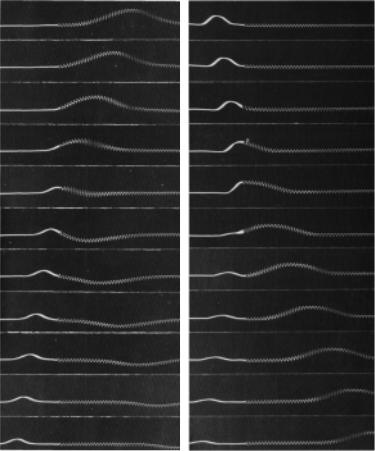
The use of the word “reflection” naturally brings to mind the creation of an image by a mirror, but this might be confusing, because we do not normally refer to “reflection” when we look at surfaces that are not shiny. Nevertheless, reflection is how we see the surfaces of all objects, not just polished ones. When we look at a sidewalk, for example, we are actually seeing the reflecting of the sun from the concrete. The reason we don’t see an image of the sun at our feet is simply that the rough surface blurs the image so drastically.
Inverted and uninverted reflections
Notice how the pulse reflected back to the right in example (c) comes back upside-down, whereas the one reflected back to the left in (d) returns in its original upright form. This is true for other waves as well. In general, there are two possible types of reflections, a reflection back into a faster medium and a reflection back into a slower medium. One type will always be an inverting reflection and one noninverting.
(c) A wave in the lighter spring, where the wave speed is greater, travels to the left and is then partly reflected and partly transmitted at the boundary with the heavier coil spring, which has a lower wave speed. The reflection is inverted.
Uncopyrighted figure from PSSC Physics.
(d) A wave moving to the right in the heavier spring is partly reflected at the boundary with the lighter spring. The reflection is uninverted.
Uncopyrighted figure from PSSC Physics.
64 |
Chapter 4 Bounded Waves |
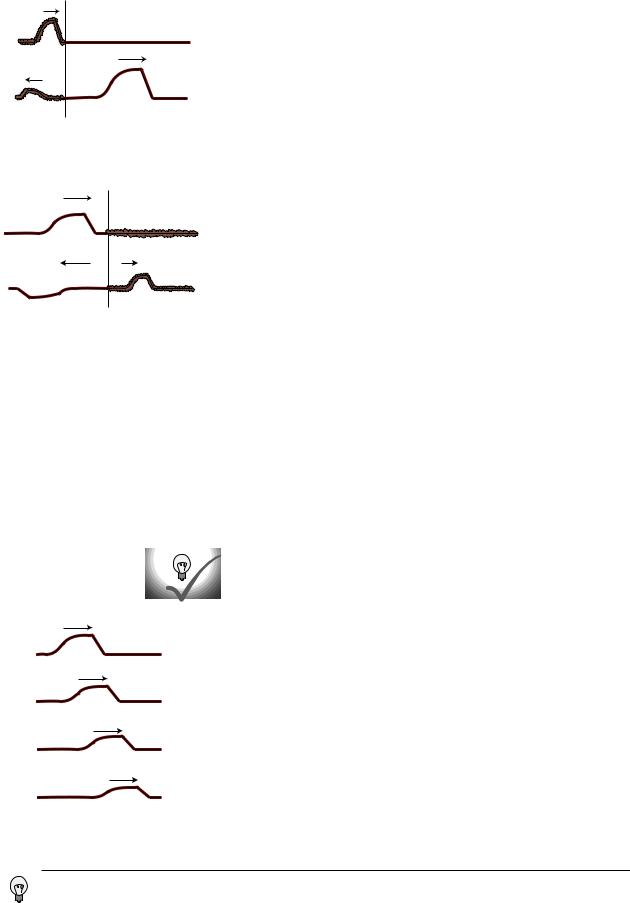
(e) An uninverted reflection. The reflected pulse is reversed front to back, but is not upside-down.
(f) An inverted reflection. The reflected pulse is reversed both front to back and top to bottom.
It’s important to realize that when we discuss inverted and uninverted reflections on a string, we are talking about whether the wave is flipped across the direction of motion (i.e. upside-down in these drawings). The reflected pulse will always be reversed front to back, as shown in figures (e) and (f). This is because it is traveling in the other direction. The leading edge of the pulse is what gets reflected first, so it is still ahead when it starts back to the left — it’s just that “ahead” is now in the opposite direction.
Absorption
So far we have tacitly assumed that wave energy remains as wave energy, and is not converted to any other form. If this was true, then the world would become more and more full of sound waves, which could never escape into the vacuum of outer space. In reality, any mechanical wave consists of a traveling pattern of vibrations of some physical medium, and vibrations of matter always produce heat, as when you bend a coathangar back and forth and it becomes hot. We can thus expect that in mechanical waves such as water waves, sound waves, or waves on a string, the wave energy will gradually be converted into heat. This is referred to as absorption.
The wave suffers a decrease in amplitude, as shown in figure (g). The decrease in amplitude amounts to the same fractional change for each unit of distance covered. For example, if a wave decreases from amplitude 2 to amplitude 1 over a distance of 1 meter, then after traveling another meter it will have an amplitude of 1/2. That is, the reduction in amplitude is exponential. This can be proven as follows. By the principle of superposition, we know that a wave of amplitude 2 must behave like the superposition of two identical waves of amplitude 1. If a single amplitude-1 wave would die down to amplitude 1/2 over a certain distance, then two ampli- tude-1 waves superposed on top of one another to make amplitude 1+1=2 must die down to amplitude 1/2+1/2=1 over the same distance.
Self-Check
(g) A pulse traveling through a highly absorptive medium.
As a wave undergoes absorption, it loses energy. Does this mean that it slows down?
In many cases, this frictional heating effect is quite weak. Sound waves in air, for instance, dissipate into heat extremely slowly, and the sound of church music in a cathedral may reverberate for as much as 3 or 4 seconds before it becomes inaudible. During this time it has traveled over a kilometer! Even this very gradual dissipation of energy occurs mostly as heating of the church’s walls and by the leaking of sound to the outside (where it will eventually end up as heat). Under the right conditions (humid air and low frequency), a sound wave in a straight pipe could theoretically travel hundreds of kilometers before being noticeable attenuated.
In general, the absorption of mechanical waves depends a great deal on the chemical composition and microscopic structure of the medium. Ripples on the surface of antifreeze, for instance, die out extremely rapidly compared to ripples on water. For sound waves and surface waves in liquids and gases, what matters is the viscosity of the substance, i.e. whether it flows
No. A material object that loses kinetic energy slows down, but a wave is not a material object. The velocity of a wave ordinarily only depends on the medium, not on the amplitude. The speed of soft sound, for example, is the same as the speed of loud sound.
Section 4.1 Reflection, Transmission, and Absorption |
65 |
easily like water or mercury or more sluggishly like molasses or antifreeze. This explains why our intuitive expectation of strong absorption of sound in water is incorrect. Water is a very weak absorber of sound (viz. whale songs and sonar), and our incorrect intuition arises from focusing on the wrong property of the substance: water’s high density, which is irrelevant, rather than its low viscosity, which is what matters.
Light is an interesting case, since although it can travel through matter, it is not itself a vibration of any material substance. Thus we can look at the star Sirius, 1014 km away from us, and be assured that none of its light was absorbed in the vacuum of outer space during its 9-year journey to us. The Hubble Space Telescope routinely observes light that has been on its way to us since the early history of the universe, billions of years ago. Of course the energy of light can be dissipated if it does pass through matter (and the light from distant galaxies is often absorbed if there happen to be clouds of gas or dust in between).
Example: soundproofing
Typical amateur musicians setting out to soundproof their garages tend to think that they should simply cover the walls with the densest possible substance. In fact, sound is not absorbed very strongly even by passing through several inches of wood. A better strategy for soundproofing is to create a sandwich of alternating layers of materials in which the speed of sound is very different, to encourage reflection.
The classic design is alternating layers of fiberglass and plywood. The speed of sound in plywood is very high, due to its stiffness, while its speed in fiberglass is essentially the same as its speed in air. Both materials are fairly good sound absorbers, but sound waves passing through a few inches of them are still not going to be absorbed sufficiently. The point of combining them is that a sound wave that tries to get out will be strongly reflected at each of the fiberglass-plywood boundaries, and will bounce back and forth many times like a ping pong ball. Due to all the back-and-forth motion, the sound may end up traveling a total distance equal to ten times the actual thickness of the soundproofing before it escapes. This is the equivalent of having ten times the thickness of sound-absorbing material.
Example: radio transmission
A radio transmitting station, such as a commercial station or an amateur “ham” radio station, must have a length of wire or cable connecting the amplifier to the antenna. The cable and the antenna act as two different media for radio waves, and there will therefore be partial reflection of the waves as they come from the cable to the antenna. If the waves bounce back and forth many times between the amplifier and the antenna, a great deal of their energy will be absorbed. There are two ways to attack the problem. One possibility is to design the antenna so that the speed of the waves in it is the same as the speed of the waves in the cable. There is then no reflection. The other method is to connect the amplifier to the antenna using a type of wire or cable that does not strongly absorb the waves. Partial reflection then becomes irrelevant, since all the wave energy will eventually exit through the antenna.
66 |
Chapter 4 Bounded Waves |
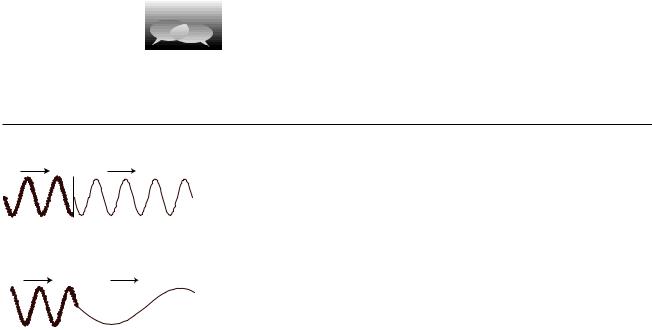
Discussion Question
A sound wave that underwent a pressure-inverting reflection would have its compressions converted to expansions and vice versa. How would its energy and frequency compare with those of the original sound? Would it sound any different? What happens if you swap the two wires where they connect to a stereo speaker, resulting in waves that vibrate in the opposite way?
4.2* Quantitative Treatment of Reflection
(a) A change in frequency without a change in wavelength would produce a discontinuity in the wave.
(b) A simple change in wavelength without a reflection would result in a sharp kink in the wave.
In this optional section we analyze the reasons why reflections occur at a speed-changing boundary, predict quantitatively the intensities of reflection and transmission, and discuss how to predict for any type of wave which reflections are inverting and which are uninverting. The gory details are likely to be of interest mainly to students with concentrations in the physical sciences, but all readers are encouraged at least to skim the first two subsections for physical insight.
Why reflection occurs
To understand the fundamental reasons for what does occur at the boundary between media, let’s first discuss what doesn’t happen. For the sake of concreteness, consider a sinusoidal wave on a string. If the wave progresses from a heavier portion of the string, in which its velocity is low, to a lighter-weight part, in which it is high, then the equation v=fλ tells us that it must change its frequency, or its wavelength, or both. If only the frequency changed, then the parts of the wave in the two different portions of the string would quickly get out of step with each other, producing a discontinuity in the wave, (a). This is unphysical, so we know that the wavelength must change while the frequency remains constant, (b).
But there is still something unphysical about figure (b). The sudden change in the shape of the wave has resulted in a sharp kink at the boundary. This can’t really happen, because the medium tends to accelerate in such a way as to eliminate curvature. A sharp kink corresponds to an infinite curvature at one point, which would produce an infinite acceleration, which would not be consistent with the smooth pattern of wave motion envisioned in fig. (b). Waves can have kinks, but not stationary kinks.
We conclude that without positing partial reflection of the wave, we cannot simultaneously satisfy the requirements of (1) continuity of the wave, and (2) no sudden changes in the slope of the wave. (The student who has studied calculus will recognize this as amounting to an assumption that both the wave and its derivative are continuous functions.)
Does this amount to a proof that reflection occurs? Not quite. We have only proven that certain types of wave motion are not valid solutions. In the following subsection, we prove that a valid solution can always be found in which a reflection occurs. Now in physics, we normally assume (but seldom prove formally) that the equations of motion have a unique solution, since otherwise a given set of initial conditions could lead to different behavior later on, but the Newtonian universe is supposed to be deterministic. Since the solution must be unique, and we derive below a valid solution involving a reflected pulse, we will have ended up with what amounts to a proof of reflection.
Section 4.2* Quantitative Treatment of Reflection |
67 |

A pulse being partially reflected and partially transmitted at the boundary between two strings in which the wave speed is different. The top drawing shows the pulse heading to the right, toward the heaver string. For clarity, all but the first and last drawings are schematic. Once the reflected pulse begins to emerge from the boundary, it adds together with the trailing parts of the incident pulse. Their sum, shown as a wider line, is what is actually observed.
Intensity of reflection
We will now show, in the case of waves on a string, that it is possible to satisfy the physical requirements given above by constructing a reflected wave, and as a bonus this will produce an equation for the proportions of reflection and transmission and a prediction as to which conditions will lead to inverted and which to uninverted reflection. We assume only that the principle of superposition holds, which is a good approximations for waves on a string of sufficiently small amplitude.
Let the unknown amplitudes of the reflected and transmitted waves be R and T, respectively. An inverted reflection would be represented by a negative value of R. We can without loss of generality take the incident (original) wave to have unit amplitude. Superposition tells us that if, for instance, the incident wave had double this amplitude, we could immediately find a corresponding solution simply by doubling R and T.
Just to the left of the boundary, the height of the wave is given by the height 1 of the incident wave, plus the height R of the part of the reflected wave that has just been created and begun heading back, for a total height of 1+R. On the right side immediately next to the boundary, the transmitted wave has a height T. To avoid a discontinuity, we must have
1+R = T .
Next we turn to the requirement of equal slopes on both sides of the boundary. Let the slope of the incoming wave be s immediately to the left of the junction. If the wave was 100% reflected, and without inversion, then the slope of the reflected wave would be –s, since the wave has been reversed in direction. In general, the slope of the reflected wave equals –sR, and the slopes of the superposed waves on the left side add up to s–sR. On the right, the slope depends on the amplitude, T, but is also changed by the stretching or compression of the wave due to the change in speed. If, for example, the wave speed is twice as great on the right side, then the slope is cut in half by this effect. The slope on the right is therefore s(v1/v2)T, where v1 is the velocity in the original medium and v2 the velocity in the new medium. Equality of slopes gives s–sR = s(v1/v2)T, or
1 – R = v 1T . v 2
Solving the two equations for the unknowns R and T gives
R = |
v 2 |
– v 1 |
|
2v 2 |
|
|
|
and T = |
|
. |
|
v 2 |
+ v 1 |
v 2 + v 1 |
|||
The first equation shows that there is no reflection unless the two wave speeds are different, and that the reflection is inverted in reflection back into a fast medium.
The energies of the transmitted and reflected wavers always add up to the same as the energy of the original wave. There is never any abrupt loss (or gain) in energy when a wave crosses a boundary. (Conversion of wave energy to heat occurs for many types of waves, but it occurs throughout the medium.) The equation for T, surprisingly, allows the amplitude of the transmitted wave to be greater than 1, i.e. greater than that of the incident wave. This does not violate conservation of energy, because this occurs
68 |
Chapter 4 Bounded Waves |
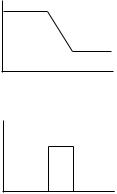
velocity
position
excess density
position
when the second string is less massive, reducing its kinetic energy, and the transmitted pulse is broader and less strongly curved, which lessens its potential energy.
Inverted and uninverted reflections in general
For waves on a string, reflections back into a faster medium are inverted, while those back into a slower medium are uninverted. Is this true for all types of waves? The rather subtle answer is that it depends on what property of the wave you are discussing.
Let’s start by considering wave disturbances of freeway traffic. Anyone who has driven frequently on crowded freeways has observed the phenomenon in which one driver taps the brakes, starting a chain reaction that travels backward down the freeway as each person in turn exercises caution in order to avoid rear-ending anyone. The reason why this type of wave is relevant is that it gives a simple, easily visualized example of our description of a wave depends on which aspect of the wave we have in mind. In steadily flowing freeway traffic, both the density of cars and their velocity are constant all along the road. Since there is no disturbance in this pattern of constant velocity and density, we say that there is no wave. Now if a wave is touched off by a person tapping the brakes, we can either describe it as a region of high density or as a region of decreasing velocity.
The freeway traffic wave is in fact a good model of a sound wave, and a sound wave can likewise be described either by the density (or pressure) of the air or by its speed. Likewise many other types of waves can be described by either of two functions, one of which is often the derivative of the other with respect to position.
Now let’s consider reflections. If we observe the freeway wave in a mirror, the high-density area will still appear high in density, but velocity in the opposite direction will now be described by a negative number. A person observing the mirror image will draw the same density graph, but the velocity graph will be flipped across the x axis, and its original region of negative slope will now have positive slope. Although I don’t know any physical situation that would correspond to the reflection of a traffic wave, we can immediately apply the same reasoning to sound waves, which often do get reflected, and determine that a reflection can either be densityinverting and velocity-uninverting or density-uninverting and velocityinverting.
This same type of situation will occur over and over as one encounters new types of waves, and to apply the analogy we need only determine which quantities, like velocity, become negated in a mirror image and which, like density, stay the same.
A light wave, for instance consists of a traveling pattern of electric and magnetic fields. All you need to know in order to analyze the reflection of light waves is how electric and magnetic fields behave under reflection; you don’t need to know any of the detailed physics of electricity and magnetism. An electric field can be detected, for example, by the way one’s hair stands on end. The direction of the hair indicates the direction of the electric field. In a mirror image, the hair points the other way, so the electric field is apparently reversed in a mirror image. The behavior of magnetic fields, however, is a little tricky. The magnetic properties of a bar magnet, for
Section 4.3 Interference Effects |
69 |

|
instance, are caused by the aligned rotation of the outermost orbiting |
|
|
electrons of the atoms. In a mirror image, the direction of rotation is |
|
|
reversed, say from clockwise to counterclockwise, and so the magnetic field |
|
|
is reversed twice: once simply because the whole picture is flipped and once |
|
|
because of the reversed rotation of the electrons. In other words, magnetic |
|
|
fields do not reverse themselves in a mirror image. We can thus predict that |
|
|
there will be two possible types of reflection of light waves. In one, the |
|
|
electric field is inverted and the magnetic field uninverted. In the other, the |
|
|
electric field is uninverted and the magnetic field inverted. |
|
4.3 |
Interference Effects |
|
|
If you look at the front of a pair of high-quality binoculars, you will |
|
|
notice a greenish-blue coating on the lenses. This is advertised as a coating |
|
|
to prevent reflection. Now reflection is clearly undesirable — we want the |
|
|
light to go in the binoculars — but so far I’ve described reflection as an |
|
|
unalterable fact of nature, depending only on the properties of the two wave |
|
|
media. The coating can’t change the speed of light in air or in glass, so how |
|
|
can it work? The key is that the coating itself is a wave medium. In other |
|
|
words, we have a three-layer sandwich of materials: air, coating, and glass. |
|
|
We will analyze the way the coating works, not because optical coatings are |
|
|
an important part of your education but because it provides a good example |
|
|
of the general phenomenon of wave interference effects. |
|
|
There are two different interfaces between media: an air-coating |
|
(a) |
boundary and a coating-glass boundary. Partial reflection and partial |
|
|
transmission will occur at each boundary. For ease of visualization let’s start |
|
|
by considering an equivalent system consisting of three dissimilar pieces of |
|
(b) |
string tied together, and a wave pattern consisting initially of a single pulse. |
|
|
Figure (a) shows the incident pulse moving through the heavy rope, in |
|
(c) |
which its velocity is low. When it encounters the lighter-weight rope in the |
|
middle, a faster medium, it is partially reflected and partially transmitted. |
||
|
||
(d) |
(The transmitted pulse is bigger, but nevertheless has only part of the |
|
original energy.) The pulse transmitted by the first interface is then partially |
||
|
reflected and partially transmitted by the second boundary, (c). In figure |
|
|
(d), two pulses are on the way back out to the left, and a single pulse is |
|
|
heading off to the right. (There is still a weak pulse caught between the two |
|
|
boundaries, and this will rattle back and forth, rapidly getting too weak to |
|
|
detect as it leaks energy to the outside with each partial reflection.) |
|
|
Note how, of the two reflected pulses in (d), one is inverted and one |
|
|
uninverted. One underwent reflection at the first boundary (a reflection |
|
|
back into a slower medium is uninverted), but the other was reflected at the |
|
(e) |
second boundary (reflection back into a faster medium is inverted). |
|
Now let’s imagine what would have happened if the incoming wave |
||
|
||
|
pattern had been a long sinusoidal wave train instead of a single pulse. The |
|
|
first two waves to reemerge on the left could be in phase, (e), or out of |
|
|
phase, (f), or anywhere in between. The amount of lag between them |
|
(f) |
depends entirely on the width of the middle segment of string. If we choose |
|
|
the width of the middle string segment correctly, then we can arrange for |
|
|
destructive interference to occur, (f), with cancellation resulting in a very |
|
|
weak reflected wave. |
70 |
Chapter 4 Bounded Waves |
